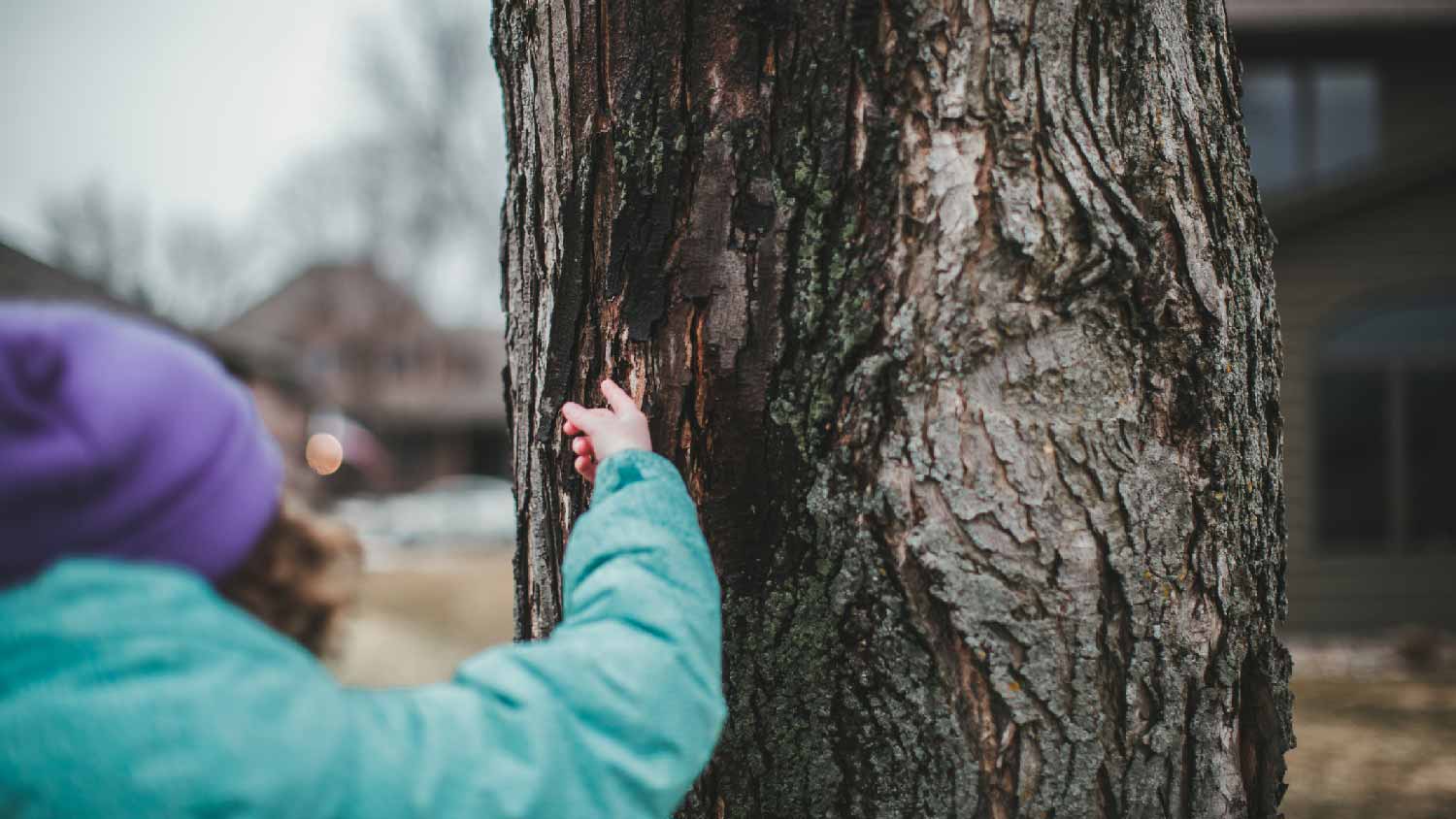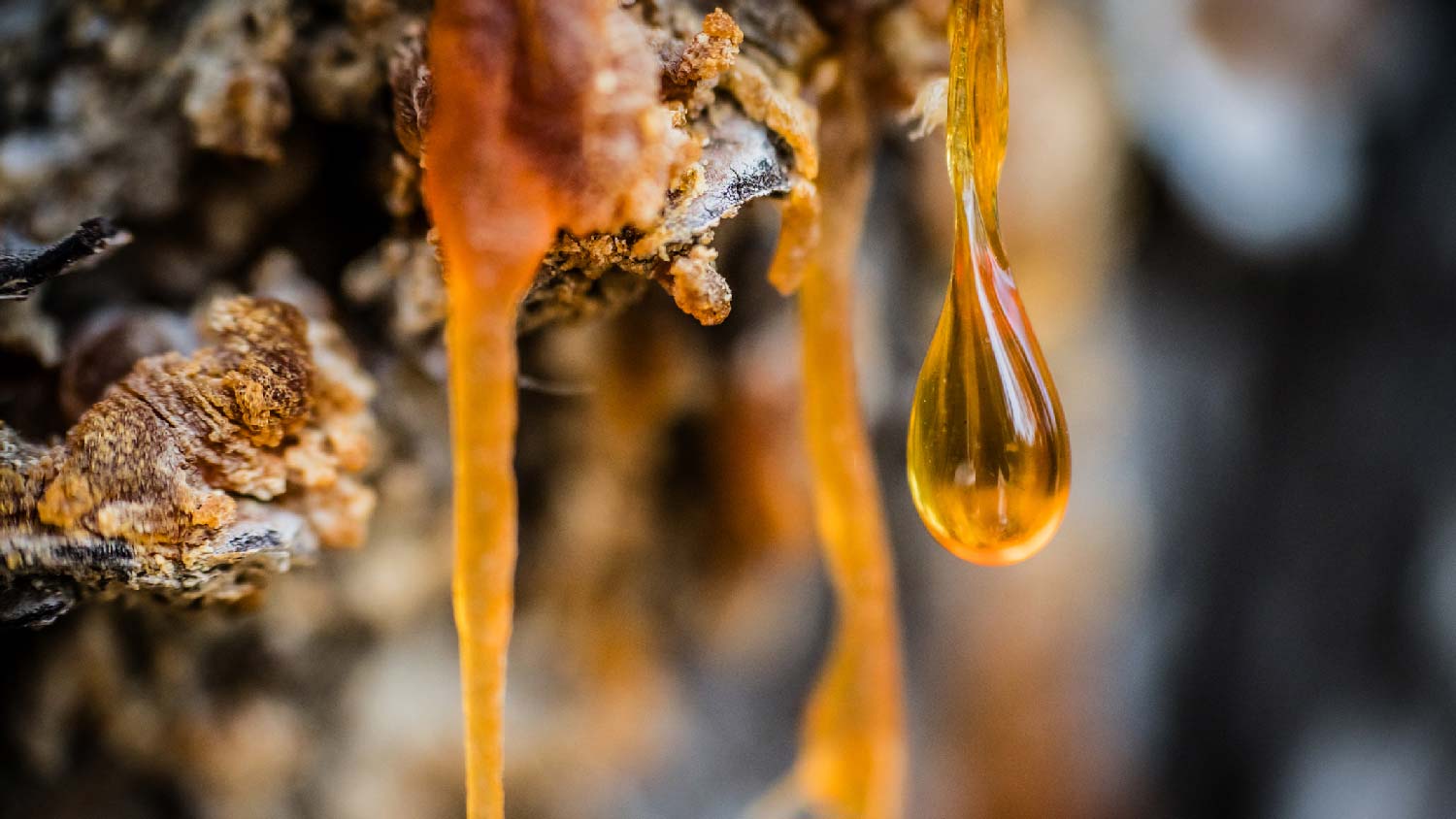
The cost of tree stump removal depends on size, removal method, location, and more. Our guide will show you how much stump removal costs.
Don’t get stuck during this simple, important task


When a tree suffers a wound, cut, or similar problem, its sap starts leaking out and causing problems. Learning how to take off tree sap is essential, especially if it drips on decks, patios, fences, walkways, or walls. Before long, it’s on toys, clothes, pets, and lawn appliances, too.
The best way to remove tree sap is a combination of patience, gentleness, and a little oil or surfactant application to make removing sap easier. The sooner you can get to this task before the sap dries, the better, so let’s get started.
Trees don’t often leak sap or resin unless something is wrong, sometimes seriously wrong. One of your first steps should be determining why your tree is leaking sap and if it’s a sign of an underlying disease or problem. Common causes can include:
Recently pruned the tree: Some sap leakage from the tips of pruned branches is expected and a natural part of the tree’s healing process. However, this sap can sometimes leak down onto walkways, decks, or cars.
Fungal diseases: Fungal diseases can often cause lesions on trees, which can lead to leaking sap. The sap tends to leak in large patches on the bark, but can also fall onto nearby objects. Fungal diseases, often carried by bugs, indicate a serious problem and should be treated before it spreads.
Aphid infestations: Aphids and any other bugs that suck the sap from trees may cause drops of sap to fall on the ground in a bad infestation. This is a common way that decks and patios can become littered with droplets of sap.
Bacterial infections: Infections like slime flux are similar to fungal diseases but are caused by bacteria eating away at the inside of a tree, causing sap leakage. They tend to start at previous wounds in the tree bark. Hire an arborist to diagnose and treat a sick tree.
Accidental damage: From hitting a tree with yard tools to storm damage, any physical damage to a tree’s trunk and branches is likely to release some sap as the tree heals.
Natural growth: Some trees naturally release sap every spring when they exit the dormant period. Others crack during periods of fast growth and leak sap the way that humans can get growing pains.

These steps should work for most smooth and semi-smooth surfaces. We recommend wearing a thick pair of gloves during the sap-removal process.
We don’t recommend removing sap from the tree trunk itself. First, you can’t easily take sap off bark without cutting the bark away, too. And trees need that sap to help heal just like our blood scabs over cuts in our skin. If you’re worried about a lesion or sappy growth on your tree, call an arborist or other expert near you instead of trying to handle it yourself.
Mix a small amount of detergent or other common house soap with a cup of warm water. Apply it to the sappy spot and wait a few minutes for the soapy mixture to soak in. Dip a clean microfiber cloth or similar cleaning cloth into the soapy mixture, and gently wash away the spots of sap. Use a light touch and try to avoid rubbing away the sap by force when possible—elbow grease could lead to surface damage.
For more stubborn sap problems, apply a small amount of mineral oil or baby oil to the sap, and let it thoroughly soak in. Try to gently remove the sap using a cloth. This method works for skin and many smooth surfaces. Dried resin may respond better to a putty knife, but be careful to avoid damaging surfaces. This method is also one of the best to remove stubborn sap from hair.
Another option for removing annoying sap is applying a lubricant like cooking spray or a formula like WD-40 to make it easier to pry the sap away. You only need a small amount, but give it several minutes to set in before you try to remove the sap.
If you have dried sap on a delicate surface like a window or car hood, try applying a bit of rubbing alcohol or isopropyl alcohol. Give it around 5 to 10 minutes to soak in, then try to remove the sap with a clean cloth. You may also want to use a putty knife or razor blade to pry the sap up, like you would an annoying sticker. Be careful and slow to avoid damaging paint or causing other problems.
For the toughest sap build-up that doesn’t respond well to other options, you can purchase a tar or adhesive remover, which are powerful solvents that remove the stickiest and most stubborn problems. You’ll have to be careful when using them since solvents can damage some surfaces or materials, but it’s a useful last resort.
If you have sap stuck to clothing, seat cushions, or other fabrics, try applying some dish soap directly to the sap and letting it work before you thoroughly wash the affected area. If the fabric is small enough to use your washing machine, rub in dish soap and then run a normal washing cycle with detergent as a one-two combo to get rid of the sap. Check clothes to make sure the sap is gone before you put them in the dryer—you don’t want the heat to melt sap.

You can cut down on the amount of sap that covers your belongings or surfaces with general maintenance and a few helpful guidelines:
Cover the tips of pruned branches: While we don’t suggest using tree sealants, which can interfere with a tree’s natural healing process, you can cover the pruned tips if you’re seriously worried about dripping sap.
Catch sap: If you know exactly where sap is going to fall, you can position a bucket underneath to catch it while the tree heals. For widespread sap issues, you can even lay down a tarp to catch the worst of it.
Clear up infestations and infections: If your tree is sick, treat it for the appropriate bug infestation or bacteria infection. Call in help from an arborist to treat a sick tree.
Keep trees well-watered: Trees may be able to fight off sap-leaking infections or bugs if they are well-watered and healthy. Take care of your trees with frequent watering.
Don’t park under trees: If you’re worried about sap falling on your car, the most effective method is simply never parking under a tree, especially in spring and summer.
Removing sap is a DIY project with the right tools. While experts may be able to suggest the best ways to remove sap from objects or surfaces, they are unlikely to offer these services.
Some exceptions do apply. If there’s a thick layer of sap on your car, for example, you may want to take it into a local auto shop and ask if they can safely remove it without damaging the paint. You can also arrange to have your deck or patio power washed, which costs between $100 and $250.
From average costs to expert advice, get all the answers you need to get your job done.

The cost of tree stump removal depends on size, removal method, location, and more. Our guide will show you how much stump removal costs.

How much does a palm tree cost? The answer depends on the type of tree, its size, and other factors. Find out how much a new palm tree costs.

Discover the average tree maintenance cost, key price factors, and tips to save. Get expert insights to plan your tree care budget with confidence.

What is a field elm vs. Siberian elm? Learn the distinguishing traits of each tree to help you identify which one is in your yard.

Wondering who to call when a tree falls in the road? The answer varies for public and private roads—find out more with this guide.

Burning a stump is a DIY stump removal option that is low-cost and effective in certain scenarios. Learn how to burn a stump safely and effectively.